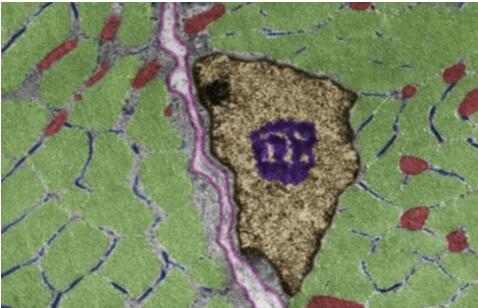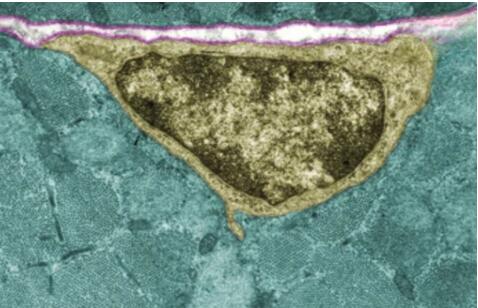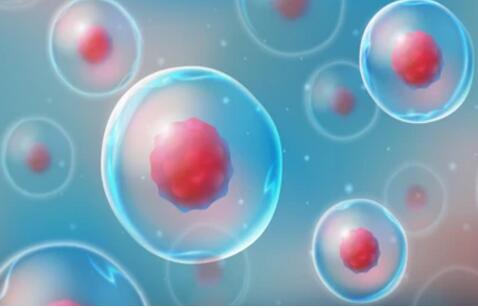Elevated CD47 Is a Hallmark of Aged Muscle Stem Cells
Cell Stem Cell, 2022 Dec 1, 29(12): 1653-1668
Authors: Porpiglia E, Mai T, Kraft P, Holbrook CA, de Morree A, Gonzalez VD, Hilgendorf KI, Frésard L, Trejo A, Bhimaraju S, Jackson PK, Fantl WJ, Blau HM.
INTRODUCTION
- Muscle stem cells (MuSCs), also known as satellite cells, reside within skeletal muscle tissue in niches juxtaposed to myofibers and are required for skeletal muscle maintenance and regeneration throughout life. There is abundant evidence that age-related loss of muscle mass and strength, also known as sarcopenia, is paralleled by the loss of MuSC function.
- High-dimensional single-cell analysis of MuSCs enabled to identify two functionally and molecularly distinct subsets, defined by differential cell surface expression of CD47. CD47lo MuSCs exhibit high regenerative capacity, whereas CD47hi MuSCs are defective in self-renewal. With aging, a shift in polyadenylation site (PAS) choice leads to a marked increase in the relative abundance of CD47hi MuSCs with impaired regenerative capacity.
METHODS
- To determine whether CD47, in combination with myogenic transcription factors, could resolve distinct MuSC subsets, the researchers performed high-dimensional CyTOF analysis. Adding a CD47 antibody to the previously established CyTOF panel, which contained antibodies against surface markers CD9 and CD104, to identify activated MuSCs and myogenic transcription factors.
- To test the role of U1 snRNA in CD47 mRNA alternative polyadenylation, the researchers designed an AMO complementary to the U1 snRNA binding site (CD47 U1 AMO) to block the binding of U1 snRNA to the CD47 mRNA 3' UTR. In addition, they designed an AMO complementary to a conserved sequence in the PAS1 (PAS1 AMO) to compete with the polyadenylation complex and force the selection of a more distal PAS.
- To determine whether exposure to thrombospondin-1 suppresses MuSC proliferation in vitro, MuSCs from young wild-type and CD47−/− mice were cultured in the presence of increasing concentrations of recombinant thrombospondin-1.
- To assess whether thrombospondin-1 blockade could mitigate the proliferative defect of aged MuSCs in vitro, we treated them with a thrombospondin-1 antibody that blocked its interaction with CD47. Then, an in vitro IdU incorporation assay followed by CyTOF analysis.
- To test this model in vivo, we treated Pax7Cre-ERT2; Rosa26LSL-Luc mice with a thrombospondin-1 blocking antibody or IgG control regimen and monitored endogenous MuSC numbers by BLI.
RESULTS
- Analysis of the high-dimensional CyTOF data, revealed three distinct clusters within the α7integrin+/CD34+ MuSC population, which were distinguished by differential expression of CD47 and the transcription factor Pax7. Compared with young, aged MuSCs showed a marked increase in CD47 mRNA and protein expression. Both the proportion of CD47hi MuSCs and the CD47 signal intensity significantly increased with aging. These data demonstrate the relative abundance of CD47lo and CD47hi shifts during aging, leading to accumulation of the CD47hi subset.
- Treatment with the PAS1 AMO led to a significant increase in the relative abundance of the long CD47 mRNA isoform and surface CD47 protein levels in young but not aged MuSCs, where the relative abundance of the long CD47 mRNA isoform and surface CD47 protein levels were already elevated prior to treatment. These findings suggest that U1 snRNA controls CD47 alternative polyadenylation and that increased U1 snRNA expression shifts the balance toward long CD47 mRNA isoform in aged MuSCs.
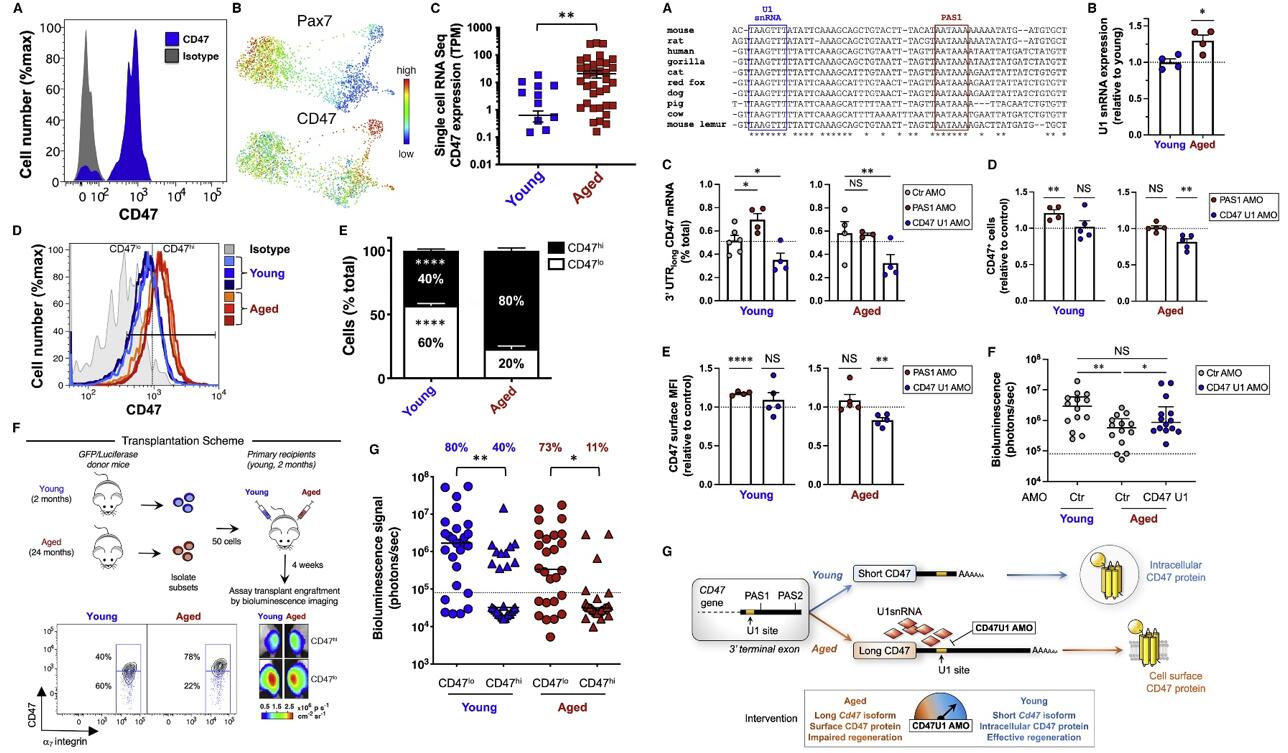 Fig. 1 Left: CD47 expression levels distinguish functionally and molecularly distinct aged muscle stem cell subsets; Right: U1 snRNA drives alternative polyadenylation and skews the balance toward long CD47 mRNA isoforms in aged muscle stem cells.
Fig. 1 Left: CD47 expression levels distinguish functionally and molecularly distinct aged muscle stem cell subsets; Right: U1 snRNA drives alternative polyadenylation and skews the balance toward long CD47 mRNA isoforms in aged muscle stem cells.
- At increasing doses of thrombospondin-1, MuSC numbers, and the fraction of iododeoxyuridine (IdU)+ and Ki67+ MuSCs significantly decreased, whereas the fraction of cleaved poly-ADP ribose polymerase (PARP)+ MuSCs remained low, demonstrating that thrombospondin-1 suppresses MuSC proliferation.
- Treating with a thrombospondin-1 antibody that blocked its interaction with CD47, proliferation of aged MuSCs was restored to levels comparable with untreated young MuSCs, whereas control CD47−/− MuSCs were refractory to this treatment. Further research suggested the significant increase in cell number upon thrombospondin-1 blockade was due to a significant increase in cell proliferation.
- In vivo treatment with the thrombospondin-1 blocking antibody was sufficient to significantly expand MuSCs in the absence of injury compared with IgG control, suggesting that thrombospondin-1 prevents MuSC activation during homeostasis. This led to a significant increase in Pax7+ cells and increased myofiber size and grip strength, compared with IgG control.
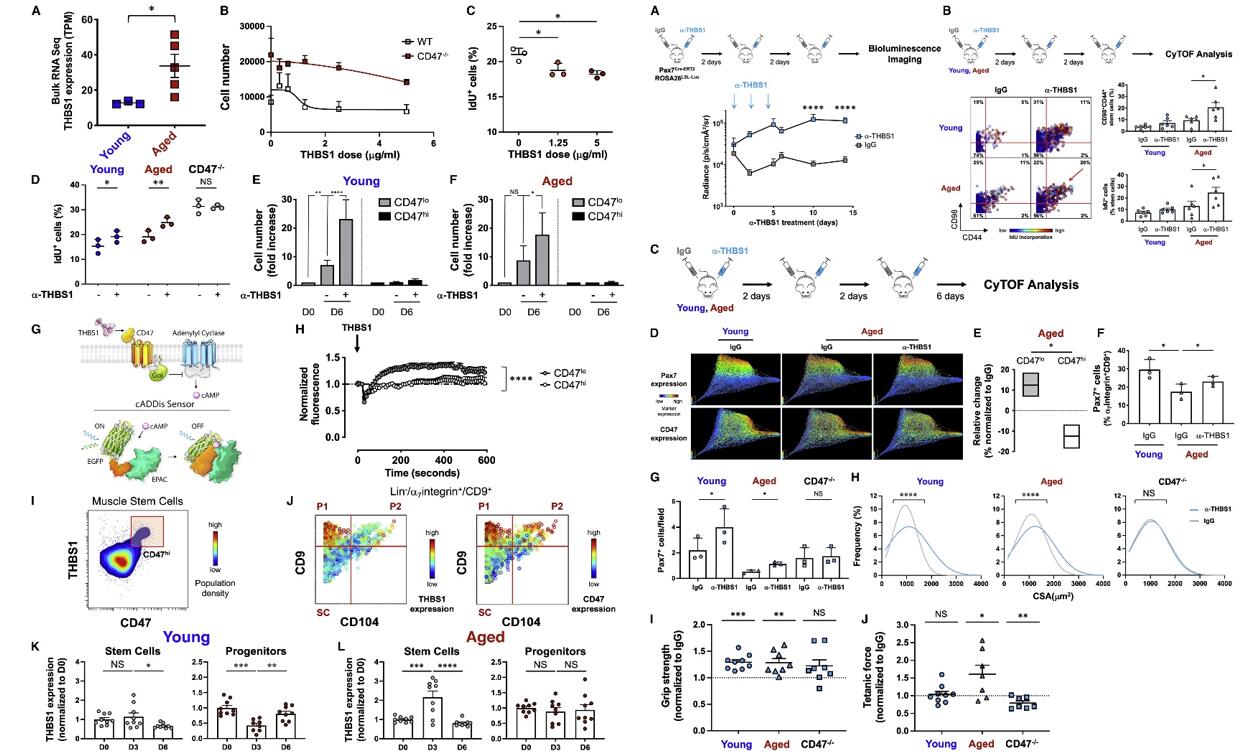 Fig. 2 Left: Aberrant thrombospondin-1 signaling via CD47 inhibits the proliferative capacity of aged muscle stem cells. Right: Thrombospondin-1 blockade in vivo activates aged muscle stem cells and increases muscle strength in absence of injury.
Fig. 2 Left: Aberrant thrombospondin-1 signaling via CD47 inhibits the proliferative capacity of aged muscle stem cells. Right: Thrombospondin-1 blockade in vivo activates aged muscle stem cells and increases muscle strength in absence of injury.
SUMMARY
- This study identifies high CD47 expression as a marker of dysfunctional MuSCs (CD47hi) with impaired regenerative capacity that predominates with ageing. And elevated CD47 levels on aged MuSCs result from increased expression of U1 snRNA expression, which disrupts alternative polyadenylation.
- Elevated CD47 levels on aged MuSCs result from increased U1 snRNA expression, which disrupts alternative polyadenylation. The deficit in aged MuSC function in regeneration can be overcome either by morpholino-mediated blockade of CD47 alternative polyadenylation or antibody blockade of thrombospondin-1/CD47 signaling.
- The present findings highlight a previously unrecognized age-dependent alteration in CD47 levels and function in MuSCs, which underlies reduced muscle repair in aging.
RELATED PRODUCTS & SERVICES
Reference
- Porpiglia E, et al. (2022). "Elevated CD47 is a hallmark of dysfunctional aged muscle stem cells that can be targeted to augment regeneration." Cell Stem Cell. 29 (12), 1653-1668.
